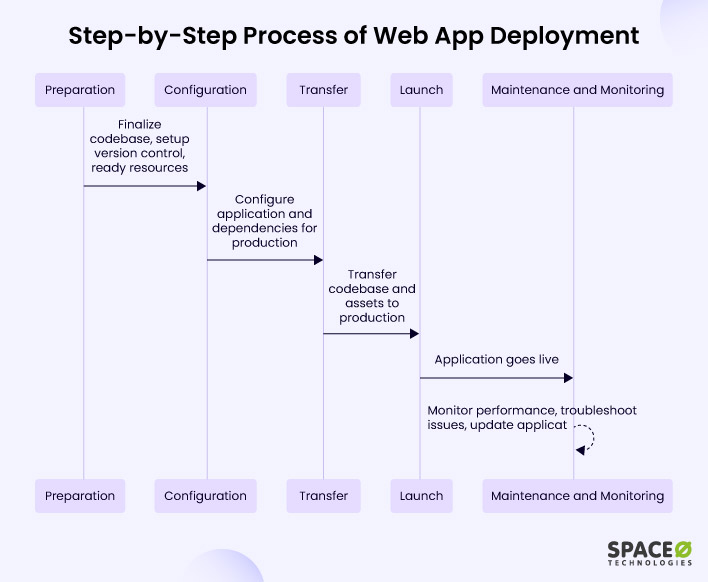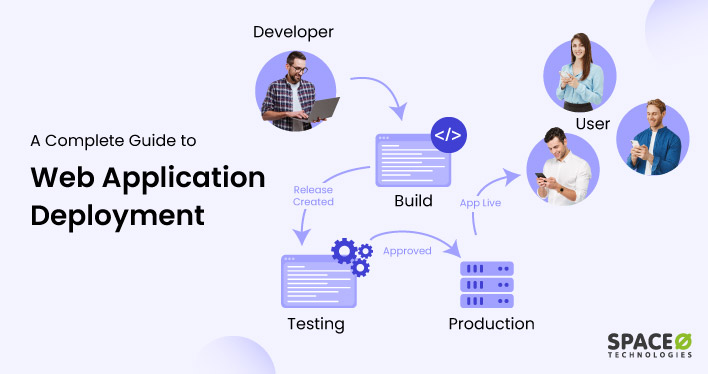- Web application deployment is a process that enables your application to be accessible to users over the Internet, ensuring its functionality in a live environment.
- Understanding the web app deployment process, including preparation, configuration, transfer, and launch, is essential for optimizing performance.
- Leveraging the right tools, methodologies, and best practices in web app deployment streamlines the process and enhances scalability.
Key Takeaways
If you are reading this blog, you want to learn about web application deployment.
You might want to know about the web application deployment process or tools/methodologies used for deploying web apps.
Being a leading web app development service provider, we have developed 100+ web app solutions for our clients. So, we have in-depth knowledge of the process, tools, methodologies, and best practices used during web app deployment.
So, we decided to write this blog and share our knowledge and insights on web app deployment.
Let’s get started with the basics.
Table of Contents
What is Deployment in Web Application?
Web app deployment refers to the process of making a web application available for end users to interact with on the internet. This involves:
- Packaging the application’s code, assets, and dependencies
- Moving them from a development environment to a production environment (often known as “pushing” to production)
- Setting up the necessary infrastructure for user access via the web
The deployment process includes tasks such as:
- Configuring a web server and managing databases
- Setting up custom domain names and optimizing performance
- Ensuring the application can scale to handle traffic
The goal is to enable the application to function seamlessly in a live, public environment, providing a smooth experience for end users.
Web app deployment plays a critical role in the software development life cycle (SDLC), which includes stages such as planning, designing, building, testing, and deployment. A deployment plan for a web application is essential to avoid issues like application errors, security vulnerabilities, and poor user experience.
Let’s further understand the process of deploying web applications on a web server with its 5-step process.
5 Step-by-Step Process of Web App Deployment
Here is a 5 easy step process about how to deploy a web application.

Prepare the Code for Deployment
Before deploying your web application from your local machine, it is important to prepare your source code for deployment. Below are three pointers to ensure that your application is ready for deployment:
- Code Finalization: The application’s codebase is finalized, meaning all features have been implemented and bugs addressed.
- Version Control Setup: Using the command line interface, a version control system, such as Git, is set up on your local machine to manage different versions of the code. This allows many developers to work on the application concurrently without overwriting each other’s changes.
- Resource Preparation: All resources the application depends on, such as databases or external APIs, are ready. This could mean setting up a real-time database, populating it with initial data, or ensuring API keys are available for external services.
Configure the Code for Deployment on the Web Server
Once the preparation is completed, the server-side code is configured for backend deployment. In this stage, the application is tailored to work in the production environment
- Environment Variables: Set up the necessary environment variables for the application. These variables can include database connection details, API keys, or any other configuration options specific to the production environment.
- Security Settings: Apply the security like setting up HTTPS for secure communication, configuring CORS settings, or setting up authentication and access controls.
- Performance Optimization: Optimize the application for best performance in the production environment. This can include tasks like minifying JavaScript and CSS files, compressing static files for faster load times, optimizing images, or setting up web server-side caching.
By configuring the application for deployment, you can ensure that it operates securely and performs optimally in the production deployment environment.
Transfer the Web Application to the Production Environment
In this stage, the focus is on transferring web apps from the development or staging environment to the production server.
The application’s code, along with any necessary assets and dependencies, is transferred to the production web server. This can be done manually via FTP or SSH, or automatically using a CI/CD pipeline. With the successful transfer, you ensure that it is ready to be launched and made accessible to users over the internet.
Launch the Web Application to the Server
The web application is made publicly available at this stage. The application is launched on the production web server of the hosting service and is now accessible to users over the internet via a specific URL.
Maintenance and Monitoring of the Web Application
Once the application has been launched, the maintenance and monitoring stage begins. This stage involves ongoing tasks to ensure the application’s optimal performance and user satisfaction. The following tasks are performed:
- Performance Monitoring: The performance of the application is continually monitored to ensure it’s running smoothly and efficiently. Tools like Google Analytics, New Relic, or Datadog can be used to track various metrics.
- Troubleshooting: If any issues are detected, they are addressed promptly. This could involve debugging code, optimizing the web servers’ resources, or resolving security vulnerabilities.
- Updates and Improvements: The application is periodically updated to add new features, improve user experience, or keep up with changing security standards. These updates typically go through their own mini-development and deployment cycles.
So, you know the 5- steps of the web app deployment process, now you might want to know tools and technologies for web app deployment.
Want to Create and Deploy Your Web App Easily?
We have a dedicated team of experts who specialize in web app development and deployment. Reach out to us now.

Web Application Deployment Methods and Tools
Different projects may require different deployment strategies. Here are a few common ones with their associated tools:
| Deployment Method | Suitable For | Associated Tools | Pros | Cons |
|---|---|---|---|---|
| Manual Deployment | Small projects or teams, simple applications | FTP, SSH | Simple to implement, no special tools required | Can be error-prone, inefficient for larger projects |
| Automated Deployment | Larger projects or teams, complex applications | Git, Jenkins, CircleCI | Efficient, reduces human error, and good for complex applications | Can require significant setup and maintenance |
| Hybrid Deployment | Applications needing the benefits of both on-premise and cloud deployments | Cloud platforms (AWS, Azure, Google Cloud), On-premise servers | Offers control of on-premise deployment and scalability of cloud deployment | Can be complex to manage, may have higher costs |
| Cloud-based Deployment | Scalable applications, applications with variable demand | Cloud providers platforms (AWS, Azure, Google Cloud) | Highly scalable, Pay for only what you use, reduces infrastructure management | Dependency on the internet, potential for vendor lock-in |
| Serverless Deployment | Event-driven applications, microservices, scalable applications | AWS Lambda, Google Cloud Functions, Azure Functions | No server management, automatic scaling, pay only for compute time you consume | Cold starts can affect performance, more difficult to debug and test |
Each deployment method and associated toolset has its own learning curve, and some may require more advanced knowledge or experience than others. Always consider these factors when deciding on the deployment platforms for your web application.
10 Best Practices for Web App Deployment
Best practices for web app deployment help ensure that the process is smooth and efficient and that your application remains stable and secure after deployment. Here are some best practices:
Use Version Control Systems
Systems like Git allow you to track changes, collaborate effectively, and maintain a history of your Git repository (GitHub repo). This practice also makes it easier to revert changes and resolve conflicts, making the development process more manageable and secure.
Employ Automated Testing
Automated tests help you catch bugs and issues before deploying a web application. This can include unit tests, integration tests, and end-to-end tests.
Implement Continuous Integration/Continuous Deployment (CI/CD)
CI/CD pipelines automate the process of testing and deploying a web application. This reduces human error and makes the process more efficient, especially when handling HTTP requests, as it ensures that the code in your production environment is always up-to-date and stable.
Leverage Configuration Management
Configuration management tools help maintain consistency in a configuration file used across environments. They ensure that all your application’s configuration files dependencies and environmental variables are correctly configured.
Optimize for the Production Environment
The production environment can differ significantly from the development environment. Things like logging, error tracking, and performance optimizations should be set up specifically for production.
Use Blue/Green or Canary Deployments
If feasible, use advanced deployment techniques like blue/green or canary deployments. They can help minimize downtime during deployments and reduce the impact of any issues with new releases.
Monitor Your Application
Monitoring is especially crucial when dealing with incoming HTTP requests. Once your application is deployed, monitor its performance, error rates, and the nature of HTTP requests it is handling. This helps you quickly identify and address issues, ensuring a better experience for your users.
Implement Security Measures
Security is critical in web app deployment. This can include measures like using secure protocols (HTTPS), managing your secrets securely, keeping software up-to-date, and following the principle of least privilege.
Plan for Scalability
Design your process with growth in mind. This can involve using scalable architectures, load balancing using load balancers, and other techniques that allow your operating system or application to handle the increased load.
Have a Rollback Strategy
Even with all these precautions, things can go wrong. Always have a strategy to quickly roll back your application to a previous stable state in case of critical issues.
Your web app is deployed. Now, it is necessary to perform post-deployment activities to maintain and update your web app. Let’s understand the 10 essential steps you can follow for post-deployment.
Want to Hire a Web Developer?
Let our team of skilled web developers deliver a high-quality web application tailored to your specific needs. Let’s discuss your project.
10 Essential Steps to Follow Post-application Deployment
Once your web application has been deployed, the work doesn’t stop there. It’s important to keep a close eye on the application to ensure its continued operation and to improve it over time. Here are some typical post-deployment activities:
- Regular monitoring of the performance of your application server and resource usage is crucial to identify potential issues early and to ensure optimal operation.
- Regular maintenance and updates of all the static files, application dependencies, and server software are essential to benefit from the latest security patches and performance improvements.
- Implementing robust error tracking and logging mechanisms can provide valuable insights into any issues, facilitating faster and more effective debugging.
- Conducting regular security audits helps to identify and address potential vulnerabilities, ensuring the application remains secure.
- Actively collecting and analyzing user feedback provides invaluable information about how the application is being used and highlights areas for potential improvement.
- Employing A/B testing strategies allows for effective comparison of different versions of the application or specific features, informing data-driven decision-making.
- Optimization should be an ongoing process, based on insights gained from monitoring, feedback, and testing, to continually enhance user experience and performance.
- Developing and deploying updates and new features, in line with user feedback and strategic planning, ensures the application remains relevant and beneficial to its users.
- Regular backups and a robust disaster recovery plan are key to ensuring quick recovery in the event of any catastrophic data loss or failure.
- Maintaining up-to-date and comprehensive documentation, both for technical stakeholders and end-users, supports the effective use of the application and smoother ongoing development and maintenance.
Remember, deployment is just one phase in the lifecycle of a web application. It’s the continuous monitoring, feedback collection, and improvement that will keep your application thriving in the long run.
Frequently Asked Questions About Web App Deployment
How does web application deployment affect the performance of a web app?
During deployment, the application is optimized for the production environment, which may be different from the development environment. Configurations are made during deployment that can impact how well the application performs under varying loads, its speed, and its uptime.
Why is choosing the right deployment method important for a web application?
Choosing the right deployment method is crucial because it determines how the application will be transferred from the development environment to the production app server. The method chosen can impact the speed and efficiency of the process, the ease of updating the application, and even the cost of running the application.
Creating and Deploying Successful Web Apps with Space-O Technologies
In this guide, we’ve taken a comprehensive look at web application deployment, showcasing its role in the lifecycle of a successful web app.
At Space-O Technologies, we go beyond creating your web application. We commit to transforming your ideas into fully-fledged, user-centric web app solutions.
Ready to get started? Reach out to us today. Let’s create and deploy your successful web app together.



